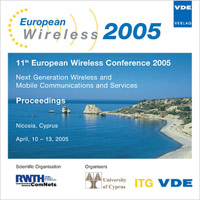On the equivalence of rate R = k/n non-systematic feed-forward convolutional codes and recursive systematic convolutional codes
Conference: European Wireless 2005 - 11th European Wireless Conference 2005 - Next Generation wireless and Mobile Communications and Services
04/10/2006 - 04/13/2005 at Nicosia, Cyprus
Proceedings: European Wireless 2005
Pages: 7Language: englishTyp: PDF
Personal VDE Members are entitled to a 10% discount on this title
Authors:
Bolinth, Edgar (Siemens AG, COM MD CTO TI 2, 46395 Bocholt, Frankenstr. 2, Germany)
Abstract:
This paper presents a new algorithm to convert non-systematic feed-forward convolutional codes (NSCC) of rate R = k/n to recursive systematic codes (RSC), while preserving code equivalence i.e. the code distance spectrum. Traditional conversion algorithms are limited to codes of rate R = k/(k+1), i.e. to n = k+1 when using encoder implementations in observer canonical form (OCF), or are restricted to codes of rate R = 1/n, i.e. to k = 1 when encoders in controller canonical from (CCF) are used. The proposed algorithm is suitable for any codes of rate R = k/n, including also n > k+1. Here, after code conversion RSCs with optimum distance spectrum (ODS) are available in OCF. However, these encoders require a more sophisticated termination than conventional methods. To provide an appropriate termination, the most general notation for linear convolutional encoders in terms of a linear equation system is introduced. This equation system is described via the ABCD-matrix notation and leads to a compact termination method, which is applicable to linear convolutional codes in general. Finally, the turbo code as specified in 3GPP is chosen as a reference to demonstrate the performance of ODS component encoders in comparison with traditional component encoders. Two performance measures have been applied: 1st the effective free distance of the overall turbo code depending on the interleaver length and 2nd bit-error-figures vs. Eb/No. This unveils the potential of ODS codes to offer superior performance compared to conventional schemes like in 3GPP and IEEE 802.16ab.


